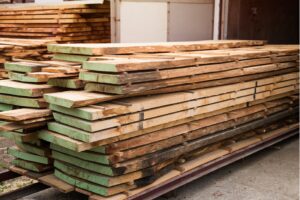
Wood, as it is found in nature, cannot be used in our everyday life: its structure, in fact, does not ensure certainty from the point of view of durability over time, because it can be damaged both by the action of wood-decay organisms (fungi, insects, bacteria and other micro-organisms of various kinds) and by the absorption of excessive amounts of water and moisture (wood is a hygroscopic material, so it acquires and loses moisture depending on the environmental conditions in which it is found).
Therefore, in order for it to be used by humans, the strength of this material must be increased, eliminating the natural fragilities that characterise the wood species. How? Through heat treatment, a process that acts on the molecular structure of wood, permanently modifying its properties (colour, density, dimensional stability) and biological durability.
Heat-treated wood: the steps of the high-temperature process
The heat treatment acts, in a totally natural way, on the molecular structure of wood (composed of cellulose, hemicelluloses and lignin), in order to permanently change its chemical-physical properties and increase its biological durability. To achieve this, it uses temperatures ranging from 90° to 250° and is divided into three stages within specific drying cells:
- Drying. This is the basic preamble to proceeding with the actual high-temperature process, because drying, in a nutshell, is the process by which the water and moisture contained in a solid are removed. As for wood, it is dried like this: the temperature of the dryer is quickly raised to around 100° by the action of steam and heat, at which point the thermal progression slows down and continues gradually more or less up to 130°. During this time, drying takes place and the wood releases almost all the moisture it contains;
- Heat treatment. We enter the most critical phase of the process, the one in which the thermal degradation of the wood’s hemicelluloses (among the main factors responsible for the permanent change in material properties) takes place. The temperature undergoes a further increase and, when slightly over 200°, is kept constant for a few hours (the actual duration depends on the use to which the wood in question will be put): it is during these instants that the final structural modification of the wood takes place;
- Cooling and moisture restoration. The final stage consists in lowering the temperature. When it reaches 80/90°, the process occurs that restores the wood the minimum amount of moisture (between 8% and 9%) required for its use.
How to treat wood with wood dryers
The indications given in the previous paragraph on the drying phase are of a general nature. If we go into the specifics, however, we realise that both the temperatures and the actual articulation of the process can vary, depending on the type of wood to be cured. However, regardless of the wood species that a dryer has to process, there is one key factor that cannot be disregarded in any context: drying must proceed in such a way that no abnormal tensions are created within the wood, from which compromising deformations and cracks can result. In order to avoid this, all aspects involved in the process must be perfectly managed: we are of course talking about the temperature inside the kiln (the higher it is, the faster the moisture leaves the surface of the wood), the humidity variations to which the wood is subjected, and the circulation of air, which acts on the material through heat, removing water.
Only a calibrated control of the above-mentioned factors provides an efficient result and, to this end, there are different types of drying:
- In chamber. The stacks of wood are placed in insulated chambers in which drying can be forced by adjusting temperature, humidity and airflow. Incomac proposes three alternatives in this respect (Icd, Tag and Idv);
- By condensation. Suitable for delicate wood, it is carried out at low temperatures, based on constant moisture monitoring. There are two Incomac machines that carry out this type of drying (Mac and Mac_Hybrid systems);
- High frequency. It is the fastest treatment, using a high-frequency electric field to overheat the wood. The Incomac solutions that work at these high temperatures are the Vap, Iht and Pal systems;
- Vacuum. In special airtight chambers, atmospheric pressure is lowered so that the drying process is accelerated even at temperatures below 90°.
The importance of wood moisture and the balance provided by drying
Moisture is one of the most relevant factors when it comes to the heat treatment of wood, especially because this material, as mentioned earlier, is hygroscopic, i.e. it is capable of absorbing moisture at every stage of its life cycle in order to reach a balance with its surroundings, varying in size and strength properties. Drying is intended precisely to generate the ideal environment so that each type of wood may release the necessary amount of water in order to be able to continue the thermal modification process without suffering setbacks or, worse, flaking of the structure.
After exposure to the scorching temperatures of the second stage of the process, moisture returns as a main player in the final cooling phase: even heat-treated wood needs to contain quantities of moisture, albeit not so high, in order to be used in everyday life. While at the same time guaranteeing the newly acquired peculiarities of stability, weather resistance and durability.
